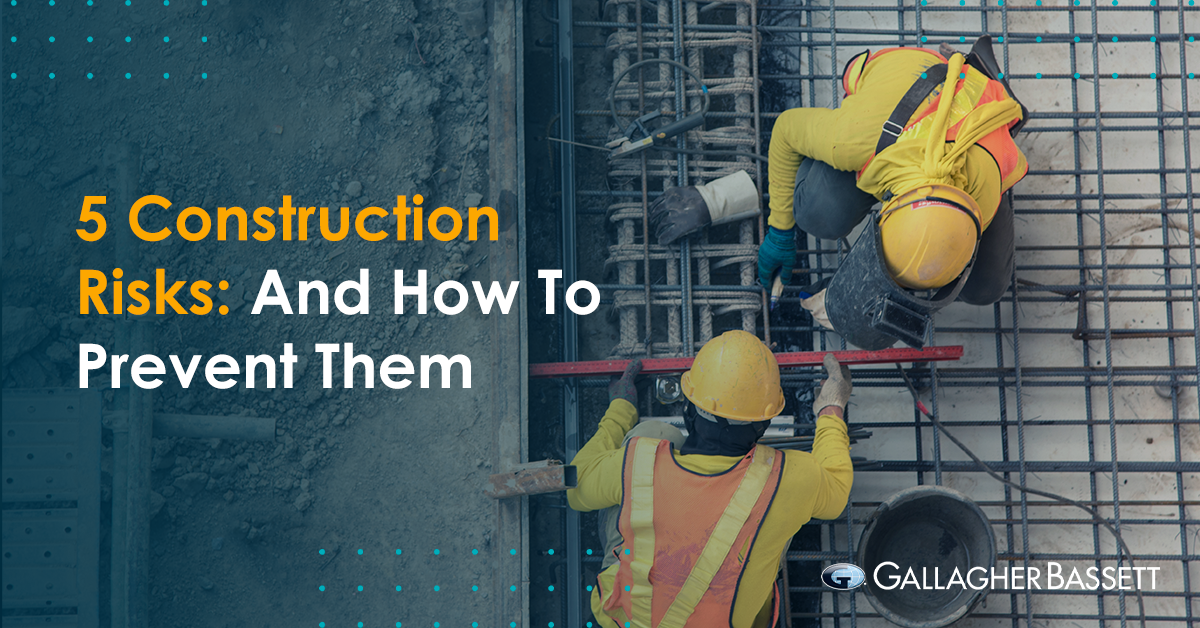5 Construction Risks And How To Prevent Them

The construction industry is a core building block of the Australian economy, though it's also one of the most dangerous. Construction site safety is a major concern for those who supervise and manage the projects. It's their role to instigate a culture of safety, minimise risk and maintain a healthy workplace.
According to Safe Work Australia's Working Compensation Statistics 2018/19, there we 14,280 total serious claims in the construction industry (second after health care and social assistance).
Construction safety requires that you recognise the most common OSHA standards and focus on reducing injury rates. Beyond serious OSHA citations, safety risks can also be a monetary issue, due to the financial implications of:
- medical costs for injuries
- civil exposure to another contractor’s injured employees or members of the public
- multi-employer contract liabilities and missed project schedules
- harm to reputation, brand and bidding ability after a highly publicised incident
Increasingly, even a single serious OSHA citation or a modest number of injuries could jeopardise construction bids that may be worth millions of dollars.
To help navigate the dangers of this high-risk industry, here are some of the most common causes of accidents and how to prevent them:
Trips and Falls
Falls happen in all workplaces, but construction sites can be especially dangerous. Sites may have hazards like uneven terrain, exposed hazards, unused materials and buildings at various stages of completion. In a moment of distraction, one of these could turn into serious injuries.
To overcome these risks, sites should ensure fall protection systems are in place along areas with unprotected edges or sides that are six feet above a lower level. This should extend to elevator shafts, skylights and excavations as well. Setting up protection barriers and safety net systems can prevent falls and reduce the distance workers if an accidental fall occurs.
Falls from scaffolding
Around 65% of all construction workers perform work at dangerously high elevations. Scaffold workers face a wide variety of dangers, including falls, electrocutions and falling objects.
In order to manage the injury risk, the structure should be designed, erected and disassembled by a qualified and competent person. A relevant safety officer should also inspect it at the start of every day to ensure that it is safe for use.
When scaffolding is set up, it should be at least 5 metres away from power lines and protected with guard rails and toeboards.
Electrocutions
As a project progresses, signs are typically set up to alert workers to the possible risks, but electric shock and electrocution can occur unintentionally. This could be from touching live parts directly or indirectly via a conducting material.
Hard hats are fitted with a layer that can protect workers from electrical shock, flying objects and other impacts. They should be worn at all times, kept in good condition and replaced immediately if they are involved in an electric shock.
Falling Objects & Debris
Falling tools, building materials or beams are common injury risks in construction sites with multilevel dwellings or buildings. Site managers can protect workers by enforcing the use of protective gear and assigning a safety monitor to conduct a risk assessment. They will help identify fall hazards and warn workers when they may be at risk of a fall hazard or potentially putting others at risk.
Another measure is to create controlled access zones to employees who are specifically required to work there and restricts visit from unauthorised persons.
Caught in/between hazards
With all the heavy machinery in use, accidents involving worker's body parts becoming trapped, squeezed, crushed or compressed between objects are a risk. These situations can arise from unguarded machinery, cave-ins or collapsing materials, and equipment rollovers.
Managing these risks requires all equipment to be properly secured and serviced. Workers should also receive proper training before using equipment that instructs them to stay focused on what they and those around them are doing. They should also be informed of potential locations for pinch, pull-in and crush points on equipment.
Site supervisors have a duty of care to employees, visitors, and those that may be affected by their activities. For construction site supervisors, the prevention of accidents is key. Follow these tips to maintain a safe work environment for both your team and clients.
Gallagher Bassett is passionate about supporting the Australian construction industry and ensuring workers are safely protected.
Accident rates can have a negative effect on project bids and significantly affect premiums. To be sure you are taking measures to reduce accidents on your worksites and discuss ways you can improve health and safety, contact us today.
